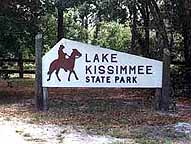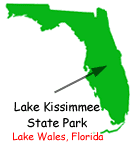| LAKE KISSIMMEE STATE PARK
 The land that is now Lake Kissimmee State Park was once used by Native Americans because of the abundance of fish and game in the area, making it an ideal place to live for thousands of years. The land that is now Lake Kissimmee State Park was once used by Native Americans because of the abundance of fish and game in the area, making it an ideal place to live for thousands of years.
The park is named for Lake Kissimmee, the third largest lake in the state. The 5,930 acres of Lake Kissimmee State Park are teeming with plant and animal life. The park offers outstanding fishing, bird watching, picnicking, camping, boating and hiking on 13 miles of beautiful trails. For nature lovers and photographers few parks offer the variety of plant and animal life that Lake Kissimmee State Park has to offer.
HISTORY
European man arrived in Florida in the 1500’s but his presence was not felt here until the 1800’s. During the third Seminole War Fort Gardiner was built nearby as a temporary fortification. Later the area was widely used for timber and turpentine. The town of Rosalie was built and later abandoned after the turpentine industry pulled out of the area.
 During the Civil War the area was used for raising cattle that were shipped to the Confederate Army or traded with Cuba for supplies. After the war, cattle were the main industry and this continues to the present day. During the Civil War the area was used for raising cattle that were shipped to the Confederate Army or traded with Cuba for supplies. After the war, cattle were the main industry and this continues to the present day.
 In 1969, the state of Florida purchased 5,030 acres of land from the William Zipprer estate for use as a state park. Lake Kissimmee State Park was opened to the public in 1977. An additional 900 acres were purchased in 1997 and added to the ’spark western boundary. In 1969, the state of Florida purchased 5,030 acres of land from the William Zipprer estate for use as a state park. Lake Kissimmee State Park was opened to the public in 1977. An additional 900 acres were purchased in 1997 and added to the ’spark western boundary.
FISHING
Located on the shores of Lakes Kissimmee, Rosalie and Tiger, the park offers some of the best fishing opportunities in the state. A variety of fish that can be caught include the largemouth bass, crappie, catfish, chain pickerel and bluegill. A boat ramp in the park offers direct access to Lake Kissimmee. For those without boats fishing opportunities from the canal banks, marina and dam offer the same variety of fish.
Freshwater fishing in Florida requires a license for those who are 15 years or older. You do not have to have a license to fish with a cane pole as long as you are fishing in the county of your residence.
CAMPING
Sixty campsites are available with electric and water hookups. No sewage hookups are provided although a dump station is located nearby. The oak hammock in which the camping area is located makes this one of the most beautiful camping areas in the state.
For those who prefer primitive camping, there are two campsites located on the 13 miles of hiking trails within the park. Everything must be backpacked in including water. There are no facilities available at either of these campsites.
A youth camping area is also available which can accommodate up to 50 youth and chaperones. Facilities available at the youth area include cold water showers.
LIVING HISTORY
 Lake Kissimmee State Park is home to an 1876 cow camp. South central Florida was the heart of ’sFlorida frontier cattle country and the life of early Florida cow hunters is interpreted at the parks living history demonstration. Walk down the dirt path and enter the year 1876 Lake Kissimmee State Park is home to an 1876 cow camp. South central Florida was the heart of ’sFlorida frontier cattle country and the life of early Florida cow hunters is interpreted at the parks living history demonstration. Walk down the dirt path and enter the year 1876  where you will find a cow hunter who is more than willing to talk about his life and times. Sample some of the camp coffee and view the herd of Florida scrub cattle, which were originally brought over by the Spanish in the early 1500's. where you will find a cow hunter who is more than willing to talk about his life and times. Sample some of the camp coffee and view the herd of Florida scrub cattle, which were originally brought over by the Spanish in the early 1500's.
The operating hours of the cow camp are weekends and major holidays from 9:30 a.m. until 4:30 p.m..
FLORA AND FAUNA
From floodplain forest to prairie hammock there is a variety of seldom seen plants. The ’spark botanical bounty includes delicate mosses, butterfly orchids, sawgrass, cutthroat grass, fetterbush and gallberry. Expansive, colorful fields of lotus and pickerelweed stretch towards the sun.
 Scrubby flatwoods are host to the Florida scrub jay, scrub oak and longleaf pine. In fact Lake Kissimmee State Park hosts over two hundred species of birds making it one of the best birding areas in central Florida. Some of the more notable species are the bald eagle, snail kite and whooping crane which can be seen on occasion. Scrubby flatwoods are host to the Florida scrub jay, scrub oak and longleaf pine. In fact Lake Kissimmee State Park hosts over two hundred species of birds making it one of the best birding areas in central Florida. Some of the more notable species are the bald eagle, snail kite and whooping crane which can be seen on occasion.
Pine flatwoods are a good place to see bobcat, grey fox and wild turkey. Of course white-tailed deer, sandhill cranes, fox squirrel and otter may be seen here as well.
Lake Kissimmee State Park boasts of 50 species of plants and animals that are either threatened, of special concern or endangered that live within the ’spark boundaries.
PICNICKING
There is a large picnic area located in an oak hammock near the bottom of the park. Large, sprawling live oak trees provide shade for those interested in picnicking at the park. There are numerous picnic tables and four pavilions available. At the edge of the picnic area is a 40 foot tall observation tower where you will be able to view the upper part of Lake Kissimmee. For further information on the availability and prices of renting the pavilions please call the park office.

Lake Kissimmee State Park is located off S.R. 60, 15 miles east of Lake Wales.
For more information on Lake Kissimmee State Park contact the park at:
Lake Kissimmee State Park
14248 Camp Mack Road
Lake Wales, FL 33853
863/696-1112
View Larger Map
|



